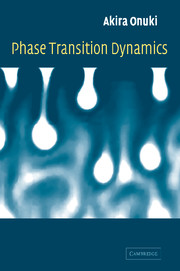8 - Phase ordering and defect dynamics
Published online by Cambridge University Press: 13 August 2009
Summary
When an external parameter such as the temperature or the pressure is changed, physical systems in a homogeneous state often become unstable and tend to an ordered phase with broken symmetry [1]–[6]. The growth of order takes place with coarsening of domain or defect structures. Such ordering processes are observed in many systems such as spin systems, solids, and fluids. Historically, structural ordering and phase separation in alloys has been one of the central problems in metallurgy. These highly nonlinear and far-from-equilibrium processes have recently been challenging subjects in condensed matter physics. We will review various theories of phase ordering, putting emphasis on the dynamics of interfaces and vortices. As newly-explored examples we will discuss spinodal decomposition in one-component fluids near the gas–liquid critical point induced by the piston effect, that in binary fluid mixtures near the consolute critical point adiabatically induced by a pressure change, that under periodic quenching, and that in polymers and gels influenced by stress–diffusion coupling. A self-organized superfluid state will also be investigated, which is characterized by high-density vortices arising from competition between heat flow and gravity.
Phase ordering in nonconserved systems
Model A
We analyze the phase ordering in model A with a one-component order parameter (n = 1) given by (5.3.3)–(5.3.5).
- Type
- Chapter
- Information
- Phase Transition Dynamics , pp. 373 - 487Publisher: Cambridge University PressPrint publication year: 2002



